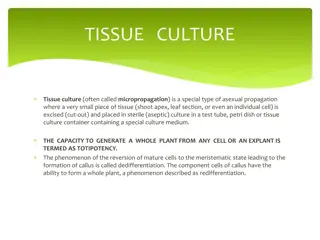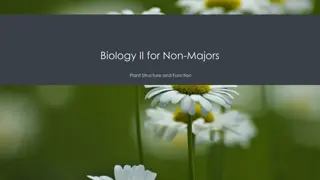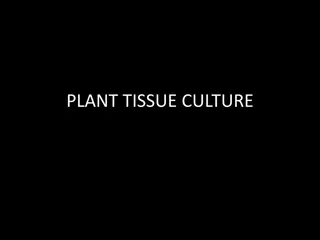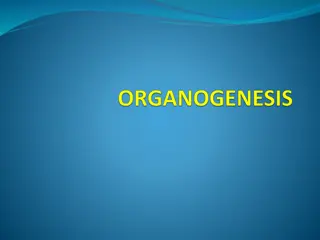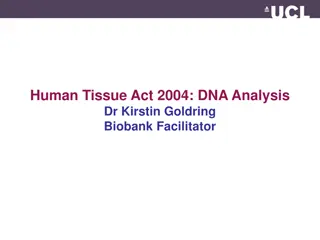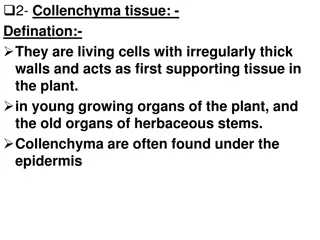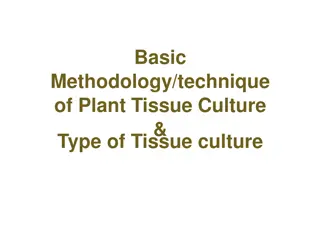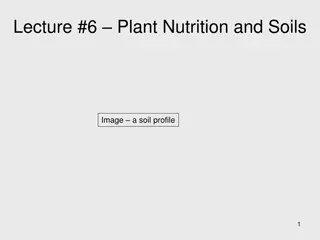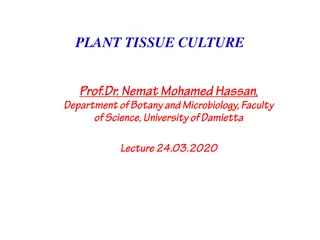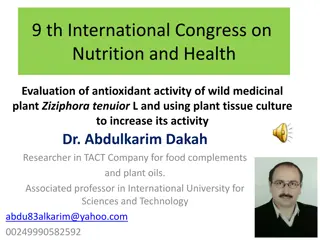Understanding Plant Tissue Culture: Methods and Requirements
Plant tissue culture involves the in-vitro culture of plant explants under aseptic conditions, covering cell, organ, and suspension cultures. This process, pioneered by German botanist Gottlieb Haberlandt, relies on the totipotency of plant cells. Key requirements include laboratory organization, suitable culture media, and strict aseptic conditions. Components like organic supplements, vitamins, antibiotics, amino acids, and inorganic nutrients play crucial roles in the success of tissue culture. Understanding the essentials of plant tissue culture is vital for successful cultivation practices.
Download Presentation

Please find below an Image/Link to download the presentation.
The content on the website is provided AS IS for your information and personal use only. It may not be sold, licensed, or shared on other websites without obtaining consent from the author. Download presentation by click this link. If you encounter any issues during the download, it is possible that the publisher has removed the file from their server.
E N D
Presentation Transcript
Tissue Culture Pinaki Kr. Rabha
The term tissue culture may be defined as the process of in-vitro culture of explants in nutrient medium under aseptic conditions. It includes the culture of cell, organ culture and suspension culture etc. German botanist Gottlieb Haberlandt was regarded as father of tissue culture. The basis of tissue culture is totipotency of cell.
German botanist Gottlieb Haberlandt first attempted to culture plant tissues in vitro . He started his work in 1898. He used cells from palisade tissues of leaves, cells from pith, epidermis and epidermal hairs of various plants for culture in media -containing Knop s solution, asparagine, peptone and sucrose.
The main requirements of plant tissue culture are: (1) Laboratory Organisation (2) Culture Media (3) Aseptic Conditions
Laboratory Organisation: i. A Media Room for preparation, sterilization and storage of culture media. ii. Facilities for washing of lab-wares, explants, etc. iii. Space for storage of lab-wares. iv. Culture rooms or incubators where conditions of temperature, humidity and light etc. can be maintained. v. Observation and Data Collection area.
Culture Media: The formulation or the medium on which the explant is cultured is called culture medium. It is composed of various nutrients required for proper culturing. Different types of plants and organs need different compositions of culture media. Anumber of media have been devised for specific tissues and organs. Some important of them are: MS (Murashige and Skoog) Medium LS (Linsmaier and Skoog) Medium B5 (Gamborg s) Medium White s Medium, etc.
Important constituents of a culture medium are: i) Organic supplements: (a) Vitamins like thiamine (B1), Pyridoxin (B6), NicotinicAcid (B3), etc. (b)Antibiotics like Streptomycin, Kanamycin; (c) Amino Acids likeArginine,Asparagine. (ii) Inorganic Nutrients: Micronutrients as Iron (Fe), Manganese (Mn), Zinc (Zn), Molybdenum (Mo), Copper (Cu), Boron (B). Macronutrients include six major elements as Nitrogen (N), Sulphur (S), Phosphorus (P), Potassium (K), Calcium (Ca), Magnesium (Mg). (iii) Carbon and Energy Source: Most preferred carbon source is Sucrose. Others include lactose, maltose, galactose, raffinose, cellobiose, etc.
(iv) Growth Hormones: a.Auxins-mainly for inducing cell division. b. Cytokinins-mainly differentiation. c.AbscisicAcid (ABA)-Used occasionally. d. Gibberellins-Used occasionally. GellingAgents: These are added to media to make them semisolid or solid. Agar, Gelatin, Alginate etc. are common solidifying or gelling agents. Other Organic Extracts: Sometimes culture media are supplemented with some organic extracts also like coconut milk, orange juice, tomato juice, potato extract, etc. for modifying apical dominance and shoot
Aseptic Conditions: Maintenance of aseptic conditions is the most critical and difficult aspect of in-vitro culturing experiments. The most common contaminants in culture are fungi and bacteria. Measures to be taken for maintaining asepsis during tissue culture are: i. Sterilization of the culture vessels using detergents, autoclaves, etc. ii. Sterilization of instruments like forceps, needles etc. by flame sterilization. iii. Sterilization of culture medium using filter sterilization or autoclaving methods. iv. Surface sterilization of explants using surface disinfectants like Silver Nitrate (1%), H2O2(10-12%), Bromine water (1-2%), Sodium Hypochlorite solution (0.3-0.6%), etc.
General Technique of Plant Tissue Culture: General technique of plant cell, tissue and organ culture is almost the same with a little variation for different plant materials. There are certain basic steps for the regeneration of a complete plant from an explant cultured on the nutrient medium .
(a) Selection and Sterilization of Explant: Suitable explant is selected and is then excised from the donor plant. Explant is then sterilized using disinfectants. (b) Preparation and Sterilization of Culture Medium: A suitable culture medium is prepared with special attention towards the objectives of culture and type of explant to be cultured. Prepared culture medium is transferred into sterilized vessels and then sterilized in autoclave.
(c) Inoculation: Sterilized explant is inoculated (transferred) on medium under aseptic conditions. (d) Incubation: Cultures are incubated in the growth chamber/ tissue culture room at 25 2 C, 50-60% relative humidity and photoperiod. After define period callus develops on the medium or shoots/ roots explant. the culture 16 hours of develops from
(e) Sub culturing: Cultured cells are transferred to a fresh nutrient medium to obtain the plantlets. (f) Hardening: Hardening is the gradual exposure of plantlets for acclimatization to environmental conditions. (e) Transfer of Plantlets: After the hardening process, the plantlets are transferred to green house or in pots.
Applications of Plant Tissue Culture 1. Germplasm conservation mainly in the form of cryopreservation of somatic embryos or shoot apices, etc. 2. Some plants produce secondary metabolic products, such as, alkaloid, anti- biotic, glycoside, resin, tannin, saponin, volatile oil, etc., which are of considerable economic importance. By cell culture various secondary metabolites (e.g. allergin) have been synthesised artificially. Cultivation of plants producing secondary metabolites can be improved significantly by tissue culture. 3. Technique of micro propagation for enhancing the rate of multiplication of economically important plants. 4. Eradication of systemic diseases in plants and raising disease free plants.
5. Soma-clonal variations are useful sources of introduction of valuable genetic variations in plants. 8. Embryo culture helps in overcoming seed sterility and dormancy. 9. Haploid production in culture helps to solve various problems of genetic studies and thus aids the plant breeders for producing new varieties. 10. Seedless fruits and vegetables can be produced by following the endosperm culture method which add to their commercial values.
11. Plant tissue culture aids in producing the genetically transformed plants. 12. Early flowering can be induced by in-vitro culturing of plants so as to attain commercial benefits. 13. Triploids as well as polyploid plants can also be produced by tissue culture techniques for uses in plant breeding, horticulture and forestry. 14. Different tissue culture techniques help us to study various biosynthetic processes, physiological changes and cytogenetic changes.









